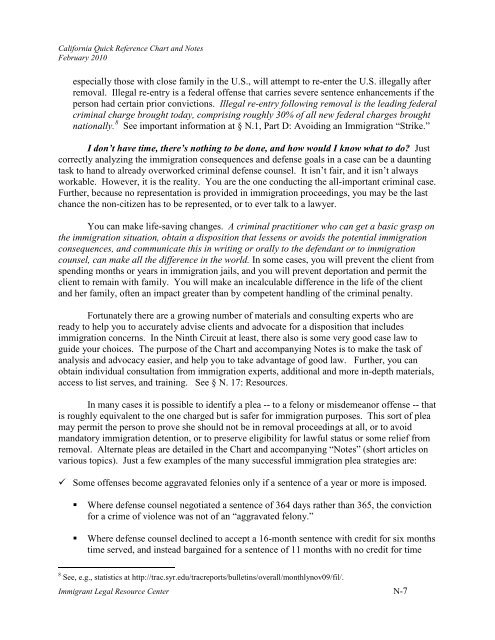quick reference chart and notes for determining immigration - ILRC
quick reference chart and notes for determining immigration - ILRC
quick reference chart and notes for determining immigration - ILRC
You also want an ePaper? Increase the reach of your titles
YUMPU automatically turns print PDFs into web optimized ePapers that Google loves.
Cali<strong>for</strong>nia Quick Reference Chart <strong>and</strong> Notes<br />
February 2010<br />
especially those with close family in the U.S., will attempt to re-enter the U.S. illegally after<br />
removal. Illegal re-entry is a federal offense that carries severe sentence enhancements if the<br />
person had certain prior convictions. Illegal re-entry following removal is the leading federal<br />
criminal charge brought today, comprising roughly 30% of all new federal charges brought<br />
nationally. 8 See important in<strong>for</strong>mation at § N.1, Part D: Avoiding an Immigration “Strike.”<br />
I don’t have time, there’s nothing to be done, <strong>and</strong> how would I know what to do? Just<br />
correctly analyzing the <strong>immigration</strong> consequences <strong>and</strong> defense goals in a case can be a daunting<br />
task to h<strong>and</strong> to already overworked criminal defense counsel. It isn’t fair, <strong>and</strong> it isn’t always<br />
workable. However, it is the reality. You are the one conducting the all-important criminal case.<br />
Further, because no representation is provided in <strong>immigration</strong> proceedings, you may be the last<br />
chance the non-citizen has to be represented, or to ever talk to a lawyer.<br />
You can make life-saving changes. A criminal practitioner who can get a basic grasp on<br />
the <strong>immigration</strong> situation, obtain a disposition that lessens or avoids the potential <strong>immigration</strong><br />
consequences, <strong>and</strong> communicate this in writing or orally to the defendant or to <strong>immigration</strong><br />
counsel, can make all the difference in the world. In some cases, you will prevent the client from<br />
spending months or years in <strong>immigration</strong> jails, <strong>and</strong> you will prevent deportation <strong>and</strong> permit the<br />
client to remain with family. You will make an incalculable difference in the life of the client<br />
<strong>and</strong> her family, often an impact greater than by competent h<strong>and</strong>ling of the criminal penalty.<br />
Fortunately there are a growing number of materials <strong>and</strong> consulting experts who are<br />
ready to help you to accurately advise clients <strong>and</strong> advocate <strong>for</strong> a disposition that includes<br />
<strong>immigration</strong> concerns. In the Ninth Circuit at least, there also is some very good case law to<br />
guide your choices. The purpose of the Chart <strong>and</strong> accompanying Notes is to make the task of<br />
analysis <strong>and</strong> advocacy easier, <strong>and</strong> help you to take advantage of good law. Further, you can<br />
obtain individual consultation from <strong>immigration</strong> experts, additional <strong>and</strong> more in-depth materials,<br />
access to list serves, <strong>and</strong> training. See § N. 17: Resources.<br />
In many cases it is possible to identify a plea -- to a felony or misdemeanor offense -- that<br />
is roughly equivalent to the one charged but is safer <strong>for</strong> <strong>immigration</strong> purposes. This sort of plea<br />
may permit the person to prove she should not be in removal proceedings at all, or to avoid<br />
m<strong>and</strong>atory <strong>immigration</strong> detention, or to preserve eligibility <strong>for</strong> lawful status or some relief from<br />
removal. Alternate pleas are detailed in the Chart <strong>and</strong> accompanying “Notes” (short articles on<br />
various topics). Just a few examples of the many successful <strong>immigration</strong> plea strategies are:<br />
Some offenses become aggravated felonies only if a sentence of a year or more is imposed.<br />
• Where defense counsel negotiated a sentence of 364 days rather than 365, the conviction<br />
<strong>for</strong> a crime of violence was not of an “aggravated felony.”<br />
• Where defense counsel declined to accept a 16-month sentence with credit <strong>for</strong> six months<br />
time served, <strong>and</strong> instead bargained <strong>for</strong> a sentence of 11 months with no credit <strong>for</strong> time<br />
8 See, e.g., statistics at http://trac.syr.edu/tracreports/bulletins/overall/monthlynov09/fil/.<br />
Immigrant Legal Resource Center N-7

















